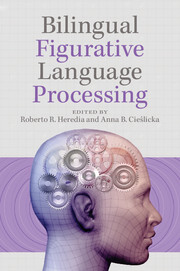Book contents
- Frontmatter
- Dedication
- Contents
- Contributors
- Acknowledgments
- Foreword
- Preface
- Section I Theoretical Implications
- Section II Methodological Approaches
- 4 Metaphoric Reference: A Real-Time Analysis
- 5 Nonliteral Language Processing and Methodological Considerations
- Section III Figurative Language Processing
- Section IV Cross-Linguistic Approaches and Applied Issues
- Author Index
- Subject Index
- References
5 - Nonliteral Language Processing and Methodological Considerations
Published online by Cambridge University Press: 05 February 2015
- Frontmatter
- Dedication
- Contents
- Contributors
- Acknowledgments
- Foreword
- Preface
- Section I Theoretical Implications
- Section II Methodological Approaches
- 4 Metaphoric Reference: A Real-Time Analysis
- 5 Nonliteral Language Processing and Methodological Considerations
- Section III Figurative Language Processing
- Section IV Cross-Linguistic Approaches and Applied Issues
- Author Index
- Subject Index
- References
Summary
Abstract
This chapter explores the various methodological tasks employed in the study of bilingual figurative language processing. In the first part of the chapter, we discuss classic behavioral reading paradigms such as rapid serial visual presentation, visual and auditory moving windows, and the newly developed reading integration maze task, as well as eye tracking. The second section focuses on the cross-modal lexical priming task (Swinney, 1979). Finally, we provide an overview on what event-related potentials (ERPs) can tell us about how bilinguals process figurative language. Advantages and disadvantages of these experimental techniques, as well as the implications of task demands for bilingual figurative language processing, are also discussed.
Keywords: bilingual figurative language, cross-modal lexical priming, event related potentials, online tasks, reading tasks
A fundamental characteristic of language is that, over time, it evolves and adapts to readily fit different linguistic needs. Figurative language is linguistic evolution at its best because it describes concrete and abstract ideas by moving beyond literal constructs and using nonliteral meanings to reach an effect. Expressions such as kick the bucket or stop bulldozing me reflect this capacity. We laugh (as in puns and jokes), learn and share life experiences or wisdom (as in idioms and proverbs), emphasize certain messages (e.g., irony and hyperbole), and compare our worlds (e.g., similes and metaphors), as figures of speech enhance our communicative effort. How do bilingual or multilingual speakers comprehend figurative expressions? To illustrate, consider the interaction between a Spanish-English bilingual comedian asking another Spanish-English bilingual colleague to go to the grain.
Information
- Type
- Chapter
- Information
- Bilingual Figurative Language Processing , pp. 117 - 168Publisher: Cambridge University PressPrint publication year: 2015
References
Accessibility standard: Unknown
Why this information is here
This section outlines the accessibility features of this content - including support for screen readers, full keyboard navigation and high-contrast display options. This may not be relevant for you.Accessibility Information
- 9
- Cited by
